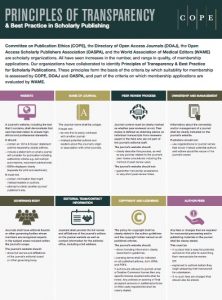Improve transparency

While journal publishing best practices can vary depending on disciplinary and geographic norms, publicly documenting your policies and workflows benefits all publications. What do you do, and why do you do it? Being open about your policies and practices helps your authors determine if your journal is a good fit for their work, your editors (both current and potential) understand the work needed to produce the journal, and your audience establish their trust with your journal.
Editorial teams should also take care to assess policies and practices on an annual or biannual basis. You may also want to periodically reach out to your editorial board, readers, authors, or other stakeholders to ask them what questions they have that you could better document on the journal website. For editors working within Florida Online Journals, Open Journal Systems (OJS) offers prompts for author and reviewer guidelines, conflict of interest policies, copyright statements, and privacy policies. The LibraryPress@UF also maintains a template of suggested language for editorial policies, which we encourage our editors to use and adapt.
In 2015, the Committee on Publication Ethics (COPE) and allied organizations released the Principles of Transparency in Scholarly Publishing. While this document is not comprehensive and does not explicitly mention DEI, it is a good starting point for any journal hoping to establish trust with its intended audience.
Craft a diversity statement
Clearly stating a commitment to diversity, equity, and inclusion is one step to signal to authors and readers that your journal values and seeks out a range of perspectives. Whether such a statement stands alone or is incorporated into your mission statement, journal staff should refer to this language when developing journal policies, writing author and peer reviewer guidance, and reaching out to your community. See a robust example from The Georgetown Law Journal and a local example from the New Florida Journal of Anthropology.
While a diversity statement in publishing instigates openness, inclusion, and participation, the first principle of diversity could be translated into transparency. Transparency requires publications to include information about the representation of race, ethnicity, gender, sexual orientation, disparities in background, disability, language, and culture into publications.
This can be achieved by assuring that communications are open and clear. Examples include statements (such as a diversity statement), activities (such as a call for papers), the scope of the editorial board, policies on authors’ rights, policies on archiving frequently updated websites and/or social media channels, and clear information about subscriptions.

